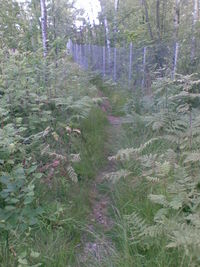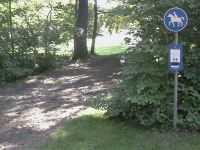Path controversy
highway=path has varied interpretation[1].
Short background
There are different customs, rules and signs in use in different countries for several kinds of ways available to pedestrian, bicycle and horse users. Tagging them has been varying, even before the introduction of highway=path in 2008 and has led to different conceptions of what the tags
imply.
Many of the detailed discussions about these choices have taken little heed of their relative ease of use for data consumers. Richard Fairhurst, author of the cycle routing application cycle.travel wrote a fierce critique of the general use of highway=path pointing out how much extra information is needed for such tagging to be usable for routers.
This page aims to gather the current conceptions and use needs. As the Key:highway claims to be "a very general and sometimes vague description of the importance of the highway" (until a vote in 2009, it was a description "of the physical structure of the highway"), it should convey something; be it that it's only "something not for motorcars" or "for specific transport mode only" - that is yet unclear. The following is as of 2024 of historic value; however highway=path is still quite a bit controversial.
Things that all agree on
- highway=footway
- Something, where walking is allowed and possible for someone. (walking might be and is allowed and possible elsewhere, too)
- highway=cycleway:
- Something, where cycling is allowed and possible
- Pedestrian access undefined - might be country dependent but not supported (yet), so there has about always been a suggestion in the wiki to always tag it with foot=no/yes/designated.
- highway=path:
- Something not wide enough for four wheeled vehicles
- OR where motorvehicles are forbidden (unless otherwise indicated by snowmobile/agricultural=designated or similar).
- May be paved or unpaved
- Anything with wheelchair=no:
- Unsuitable for wheelchair users or other mobility impaired
- Anything with highway=footway + foot=no (+ snowmobile=yes) would be silly
- highway=track
- Implies that it's wide enough for a small motorcar to drive on, even if it's illegal.
Different types of ways
Kinds of paths
| Description | wheelchair | foot | bicycle | horse | Tagging before path |
|---|---|---|---|---|---|
| Unmaintained trail | no | yes | country | country | highway=footway |
| Signposted/implied foot access only | yes | yes | no | no | highway=footway |
| Signposted as being for cycles only | no | no | yes | no | highway=cycleway + foot=no |
| Signposted for mixed use Signposted "no motor vehicles" No sign but local law allows foot and bicycle |
yes | yes | yes | sign | highway=cycleway + foot=yes |
| For horses | no | country | country | yes | highway=bridleway |
| For snowmobiles/whatever | no | no | no | no | highway=footway + foot=no |
- Sign Must be tagged depending on the sign used.
- Country Depends on country specific defaults and rights and exceptions are tagged.
By access
| Example (signposted ways) | Pedestrian in UK | Continental pedestrian | Scandinavian pedestrian | Hiker | Cyclist | Mountain- bike |
Horse | Wheelchair |
|---|---|---|---|---|---|---|---|---|
| "Way for pedestrians" | yes | yes | yes | yes | no | no | no | yes |
| "Way for cycling only" | yes | no | no | no | yes | yes | no | no |
| "Combined cycling and pedestrian way" | yes | yes | yes | yes | yes | yes | no | yes |
| "No motor vehicles" | yes | yes | yes | yes | yes | yes | no | yes |
| Built, even way with no signs at all | yes | yes | yes | yes | yes | yes | no? | yes |
| Example (not signposted) | Pedestrian in UK | Continental pedestrian | Scandinavian pedestrian | Hiker | Cyclist | Mountain- bike |
Horse | Wheelchair |
| Even unbuilt trail Could be wear marks on a park grass or a solid forest trail; people will consider it suitable if not in high heels |
permissive | permissive | yes | yes | yes | yes | permissive/yes per country | no |
| Narrow unbuilt trail Where a urban person wouldn't wan't to be routed over |
permissive | permissive | yes | yes | no | yes/permissive | yes/permissive per country | no |
| Signposted for horses | yes | no | no | no | no (UK, yes) | no | no | yes |
| Signposted for snowmobiles | n/a | n/a | no | no | no | no | no | no |
Nine kinds of ways and four highway classes.
- Bridleway hasn't been contented - legally allowed/reserved for equestrian use.
- Is a cycleway only for bicycles or is combined way also a cycleway? Do they need different rendering?
- In the past both were highway=cycleway, now opinions differ.
- It varies with country which type is more common, if not equally common.
- IMO: it's a rendering issue.
- Is a way for both cyclists and pedestrians any different from a way signposted as "no motor vehicles"?
- IMO: no, and their highway classification should be the same. Alv 15:35, 12 August 2009 (UTC)
- Is a narrow uneven trail different enough from a paved sidewalk or other signposted and modern built footway? (Where foot access on both is legal).
- IMO: yes, their highway classification should be different. Alv 15:35, 12 August 2009 (UTC)
- If yes, where to draw the line?
- Should snowmobile ways even be highways? They're legally binding and defined in the same law as other traffic regulations.
With images
- ↑ "Horridly complex tag, everyone uses it differently." - https://www.cyclestreets.net/help/journey/osmconversion/






